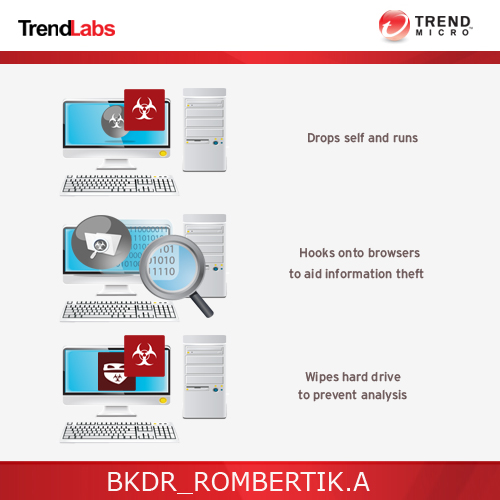BKDR_ROMBERTIK.A
Windows


Threat Type: Backdoor
Destructiveness: No
Encrypted: Yes
In the wild: Yes
OVERVIEW
This malware hooks itself onto certain browsers in the affected system for purposes of information theft. It also wipes the affected system's Master Boot Record(MBR) if it detects security detection efforts, which can cause loss of sensitive data/critical documents. Users with systems affected by this malware may have their security and critical data compromised.
To get a one-glance comprehensive view of the behavior of this Backdoor, refer to the Threat Diagram shown below.

This backdoor arrives as an attachment to email messages spammed by other malware/grayware or malicious users.
It connects to a website to send and receive information.
TECHNICAL DETAILS
Arrival Details
This backdoor arrives as an attachment to email messages spammed by other malware/grayware or malicious users.
Installation
This backdoor drops the following copies of itself into the affected system and executes them:
- %Application Data%\rsr\yfoye.exe
(Note: %Application Data% is the Application Data folder, where it usually is C:\Documents and Settings\{user name}\Application Data on Windows 2000, Windows Server 2003, and Windows XP (32- and 64-bit); C:\Users\{user name}\AppData\Roaming on Windows Vista (32- and 64-bit), Windows 7 (32- and 64-bit), Windows 8 (32- and 64-bit), Windows 8.1 (32- and 64-bit), Windows Server 2008, and Windows Server 2012.)
It drops the following files:
- %Application Data%\rsr\yfoye.bat
(Note: %Application Data% is the Application Data folder, where it usually is C:\Documents and Settings\{user name}\Application Data on Windows 2000, Windows Server 2003, and Windows XP (32- and 64-bit); C:\Users\{user name}\AppData\Roaming on Windows Vista (32- and 64-bit), Windows 7 (32- and 64-bit), Windows 8 (32- and 64-bit), Windows 8.1 (32- and 64-bit), Windows Server 2008, and Windows Server 2012.)
Autostart Technique
This backdoor drops the following file(s) in the Windows User Startup folder to enable its automatic execution at every system startup:
- %User Startup%\fgf.vbs
(Note: %User Startup% is the current user's Startup folder, which is usually C:\Windows\Profiles\{user name}\Start Menu\Programs\Startup on Windows 98 and ME, C:\WINNT\Profiles\{user name}\Start Menu\Programs\Startup on Windows NT, and C:\Documents and Settings\{User name}\Start Menu\Programs\Startup.)
Backdoor Routine
This backdoor connects to the following websites to send and receive information:
- www.{BLOCKED}os.org.in/don1/gate.php
NOTES:
It injects itself to the following web browser to monitor the user's web activities:
- iexplore.exe
- firefox.exe
- chrome.exe
Anti-Analysis Features:
In an virtual machine, it performs a looping process. This causes the sandbox to create very large logs that may eventually cause the system to crash.
Rather than performing its malicious routines, it instead displays a normal window if its filename contains any of the following strings:
- malwar
- file.
- sandb
- viru
- sampl
This malware contains anti-analysis functions that, when triggered, attempts to overwrites the Master Boot Record (MBR) of the affected system. If it fails, it attempts to encrypt the files found in the user's home folder. This renders the machine unusable or have limited functionality.
SOLUTION
Step 1
Before doing any scans, Windows XP, Windows Vista, and Windows 7 users must disable System Restore to allow full scanning of their computers.
Step 2
Search and delete this file
- %Application Data%\rsr\yfoye.bat
- %User Startup%\fgf.vbs
Step 3
Scan your computer with your Trend Micro product to delete files detected as BKDR_ROMBERTIK.A. If the detected files have already been cleaned, deleted, or quarantined by your Trend Micro product, no further step is required. You may opt to simply delete the quarantined files. Please check this Knowledge Base page for more information.
Did this description help? Tell us how we did.


